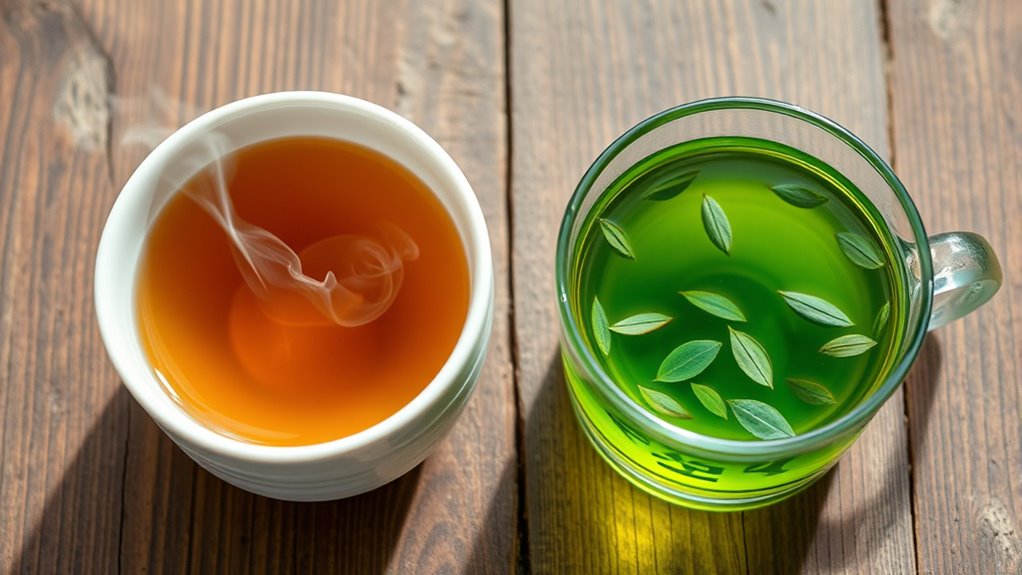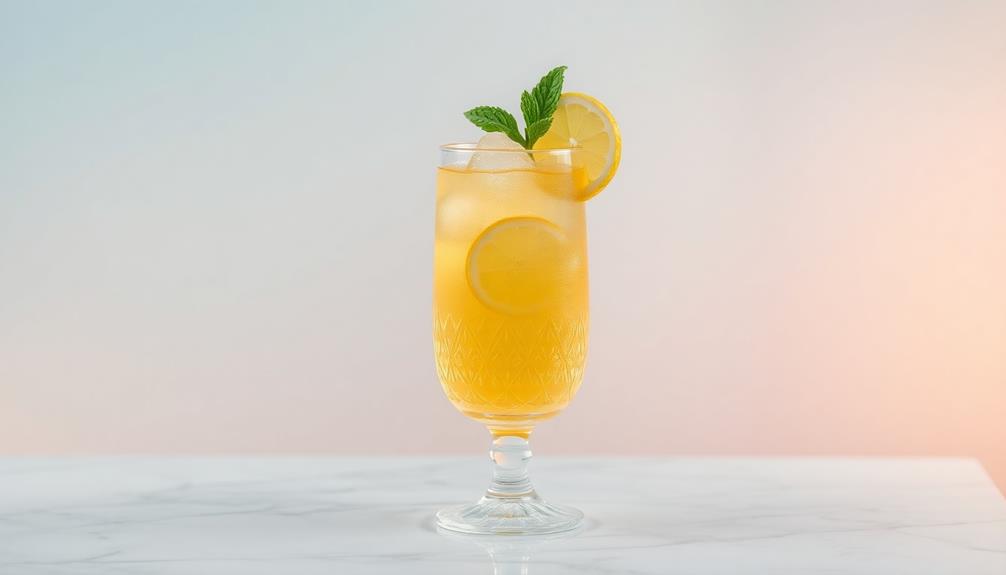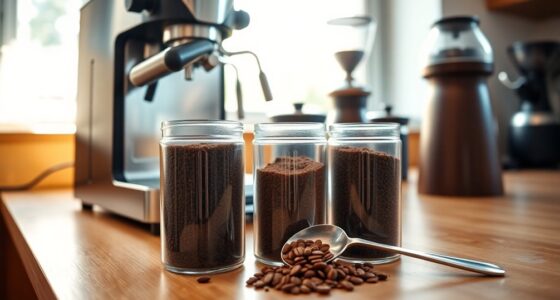Oolong and green tea both come from the same plant, but their processing makes all the difference. Green tea is minimally oxidized, giving it fresh, grassy flavors, while oolong undergoes partial oxidation, resulting in complex, floral to robust profiles. Their health benefits and caffeine levels vary too, with oolong often richer in antioxidants. To enjoy each at its best, pay attention to brewing times and vessels. If you keep exploring, you’ll uncover even more about these flavorful teas.
Key Takeaways
- Green tea is minimally oxidized, offering light, grassy flavors, while oolong undergoes partial oxidation, resulting in more complex, floral or roasted profiles.
- Oolong generally contains higher caffeine levels and antioxidants compared to green tea, influencing energy and health benefits.
- Brewing temperature and steeping time vary: green tea prefers lower temp (~175°F) and shorter steepings, whereas oolong benefits from hotter water (~195°F) and longer infusions.
- Flavor and aroma nuances depend on processing techniques, oxidation levels, and harvest timing, creating a wide spectrum of sensory experiences.
- Proper vessel choice and brewing methods significantly enhance aroma, flavor extraction, and overall enjoyment of each tea type.
The Unique Processing Methods Behind Each Brew
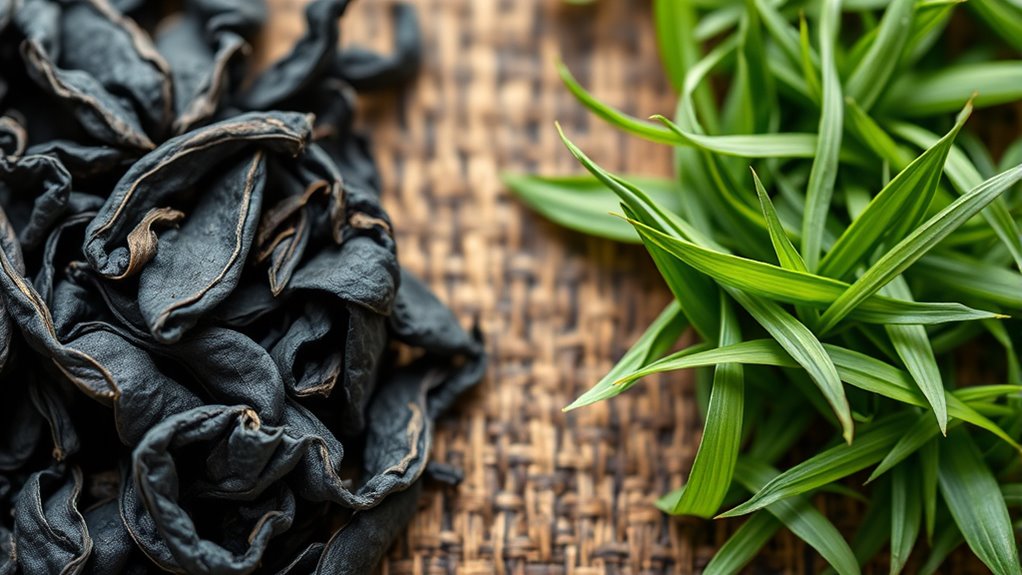
While both oolong and green teas start from the same Camellia sinensis leaves, their processing methods diverge markedly, shaping their distinct flavors and qualities. The key difference lies in the oxidation process. Green tea undergoes minimal oxidation, often just steaming or pan-firing to halt enzyme activity, preserving its fresh, grassy notes. Oolong tea, on the other hand, experiences a partial oxidation step, typically involving controlled withering and rolling. This fermentation method allows the leaves to oxidize to varying degrees—anywhere from 10% to 70%—which influences the tea’s flavor complexity. The oxidation process in oolong is carefully monitored, creating a spectrum from lightly oxidized, floral varieties to heavily oxidized, more robust types. These processing choices fundamentally shape each tea’s unique character.
Flavor Profiles and Aromatic Differences
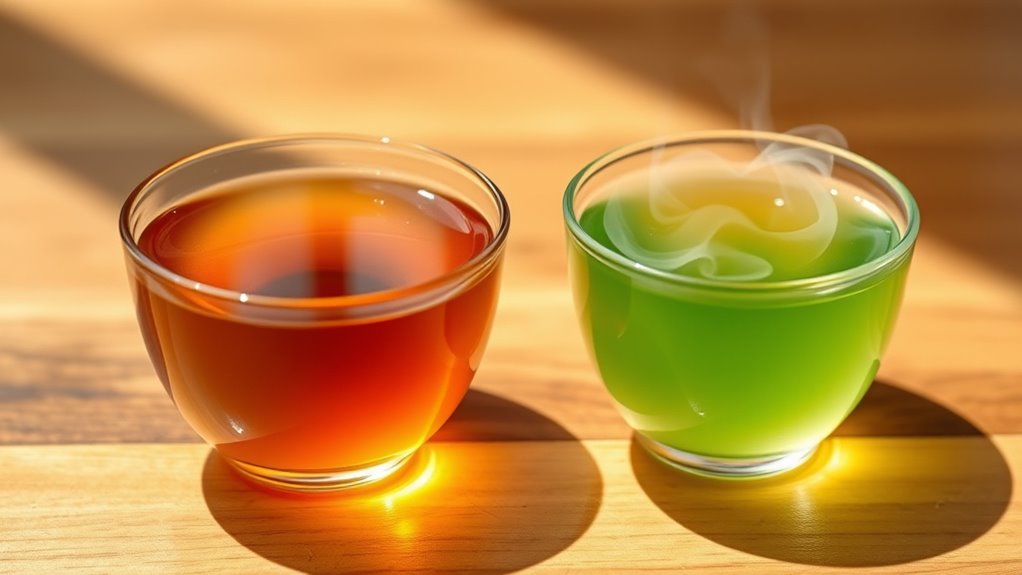
You’ll notice that oolong and green teas offer distinct flavor intensities, ranging from light and grassy to rich and roasted. Their aromatic nuances also differ, with green teas often delivering fresh, vegetal scents, while oolongs can feature complex, floral, or fruity notes. Exploring these differences helps you appreciate how processing influences each tea’s unique sensory profile. Additionally, the aroma profiles of these teas are shaped by their fermentation levels, impacting the overall tasting experience.
Flavor Intensity Variations
Oolong and green teas exhibit distinct flavor intensity variations that substantially influence your tasting experience. These differences are shaped by factors like harvesting seasons and storage conditions. Tea harvested in early seasons often results in a more delicate, subtle flavor, while later harvests tend to produce bolder, more intense profiles. Similarly, proper storage conditions—such as airtight containers away from light and moisture—help preserve the tea’s natural strength and prevent flavor loss. Oolong teas, especially those oxidized more heavily, generally deliver a richer, more robust flavor, whereas green teas tend to be lighter and more grassy. These variations mean your tea’s flavor intensity can shift noticeably depending on when it’s picked and how it’s stored, affecting the overall strength and depth of each brew. Additionally, understanding the flavor profiles can help you select the right tea for your preferred taste experience.
Aromatic Nuance Differences
The aromatic profiles of oolong and green teas differ markedly, shaping your sensory experience with each cup. Oolong teas often boast complex, roasted, and floral notes, influenced by their tea leaf origins and processing methods. Green teas typically offer fresh, grassy, and vegetal aromas, reflecting their minimal oxidation. These aromatic nuances are also shaped by marketing branding, which highlights specific flavor profiles to appeal to different preferences. Oolong’s layered fragrance can evoke toasted or honeyed scents, while green tea’s aroma tends to be lighter and more herbaceous. Recognizing these distinctions helps you appreciate the unique sensory qualities of each tea, enabling you to choose based on aroma preferences. Additionally, tea leaf processing techniques significantly contribute to these aromatic differences, allowing artisans to craft distinctive scent profiles. Ultimately, understanding these aromatic nuances deepens your appreciation of the craft behind each brew.
Health Benefits and Nutritional Insights
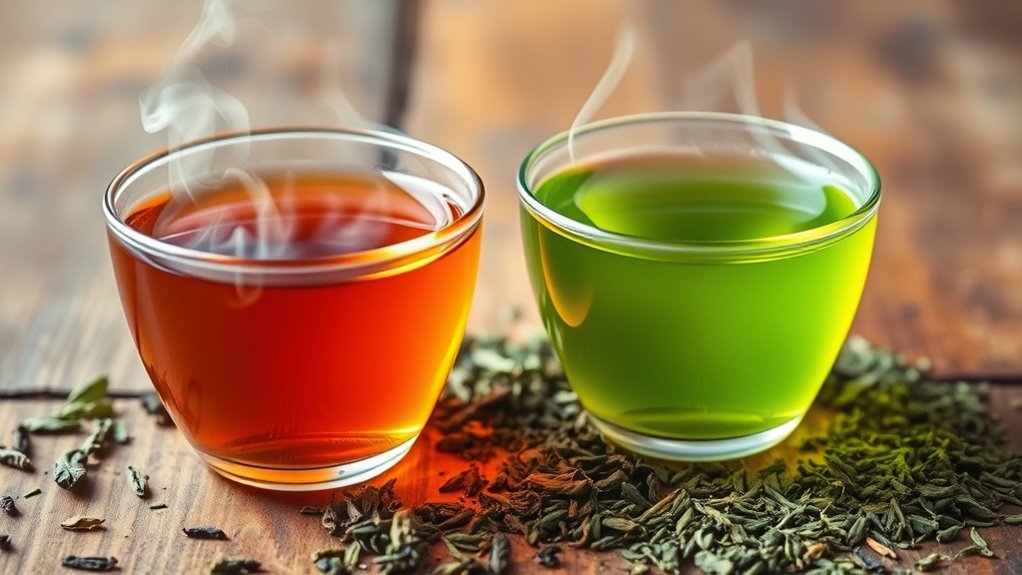
Both oolong and green teas are packed with antioxidants that can support your overall health, but they offer distinct nutritional profiles. Oolong tea generally has higher antioxidant levels, which may help reduce inflammation and fight free radicals. Green tea, on the other hand, is known for its lower calorie content, making it a great choice if you’re watching your intake. Both teas may boost your metabolism and improve heart health, but green tea’s catechins are particularly well-studied for their health benefits. Additionally, green tea contains slightly fewer calories per cup, especially if you drink it plain without added sweeteners. Incorporating mindful decluttering into your routine can also help you create a healthier environment that supports your overall well-being. Overall, incorporating either tea into your diet can enhance your nutritional intake and promote better health.
Caffeine Content and Its Effects
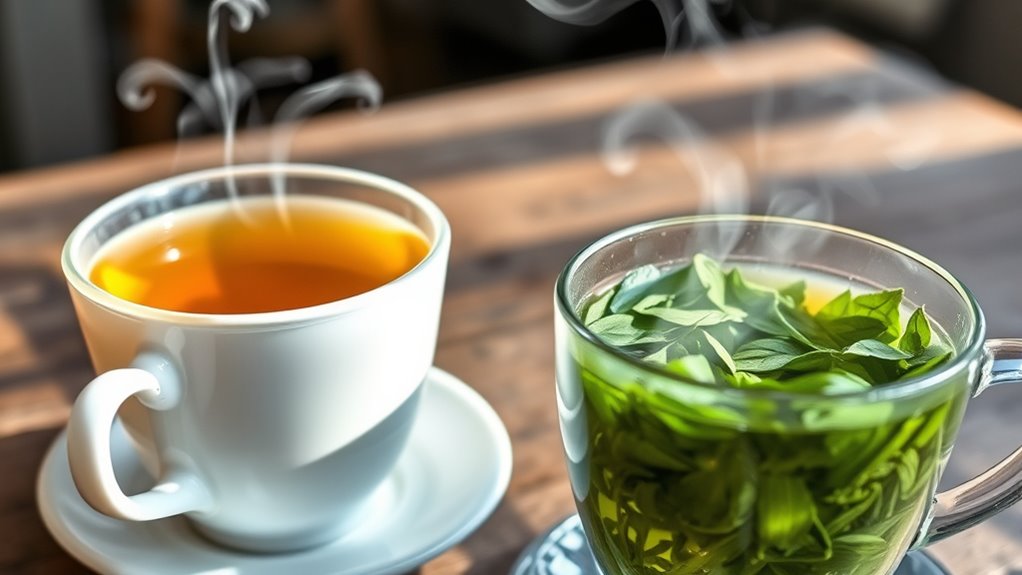
While the antioxidant content of oolong and green teas offers health benefits, their caffeine levels can considerably influence how you experience each beverage. Caffeine absorption peaks within 30-60 minutes after drinking. Green tea generally has less caffeine than oolong, but it varies by processing. Excess caffeine can cause jitteriness or increased heart rate. Sleep disruption is common if caffeine intake is too close to bedtime, affecting overall rest quality. Being aware of caffeine content in espresso can help you manage your intake and avoid unwanted side effects.
Brewing Techniques for Optimal Flavor

Getting the perfect flavor depends on precise water temperature, so make sure to adjust it based on the tea type. Keep an eye on steeping times to prevent bitterness or under-extraction, and use the right leaf-to-water ratio for balance. Small adjustments here can make a big difference in how your tea tastes. Additionally, understanding the net worth growth hacks can help you invest in quality tea supplies and accessories that enhance your brewing experience.
Water Temperature Precision
Achieving the perfect flavor in oolong and green teas depends heavily on controlling water temperature during brewing. Precise temperature ensures the delicate leaves release their nuanced flavors without bitterness or dullness. To optimize this, consider these key points:
- Use high-quality brewing equipment with temperature controls to maintain consistent heat.
- Store tea properly—away from heat and moisture—to preserve freshness and prevent flavor loss.
- Aim for about 175°F (80°C) for green tea, and slightly higher, around 195°F (90°C), for oolong.
- Always preheat your teapot or cup to avoid temperature fluctuations that can compromise extraction.
Keeping these factors in check guarantees you extract the full potential of your tea leaves, elevating your brewing craft.
Steeping Duration Tips
To unseal the full flavor of your oolong and green teas, paying close attention to steeping duration is essential. Leaf oxidation influences how long you should steep each tea; greener teas with less oxidation often need shorter steeping times, while more oxidized oolongs can handle longer steeping. Keep your steeping temperature consistent, as it impacts how quickly flavors are extracted. Oversteeping can lead to bitterness, especially in green tea, while understeeping may result in weak flavor. For maximum results, generally steep green teas for 2–3 minutes, and oolongs for 3–5 minutes, adjusting based on leaf oxidation and personal taste. Monitoring the steeping duration ensures you extract the delicate flavors without overpowering the tea’s natural essence. Paying attention to steeping techniques can also help prevent overextraction and bitterness.
Leaf-to-Water Ratio
The right leaf-to-water ratio is key to revealing the full flavor of your oolong or green tea. Using too much tea can make it bitter, while too little may result in a weak brew. Pay attention to your brewing vessel choices, as they influence extraction and flavor. Here are some tips to optimize your ratio:
- Use approximately 1 teaspoon (2-3 grams) of loose leaf per 8 oz of water for green tea.
- For oolong, consider 1.5 teaspoons (3-4 grams) per 8 oz, adjusting based on leaf size.
- Opt for narrow, ceramic or glass vessels to maintain even heat and better control.
- Adjust the leaf-to-water ratio depending on steeping times and personal taste preferences.
- Remember that the rustic charm of your brewing setup can also impact the overall experience and flavor extraction.
Fine-tuning these elements guarantees a balanced, flavorful cup.
Common Myths and Misconceptions
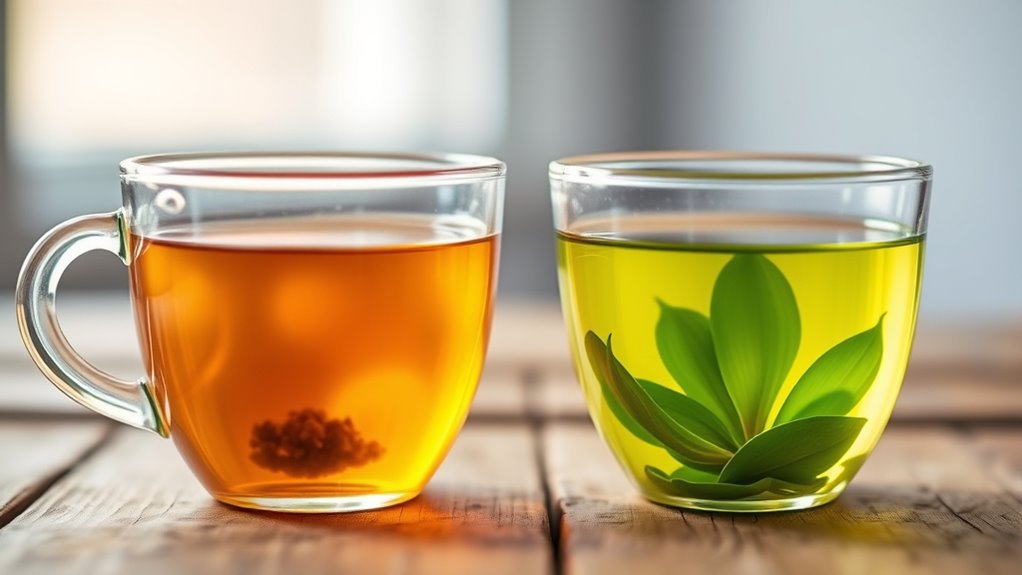
Many people believe that all green teas and oolong teas offer the same health benefits, but this is a misconception. Myth busting reveals that each tea type contains different compounds and antioxidants, which influence their benefits. For instance, green tea is rich in catechins, known for boosting metabolism and protecting cells, while oolong tea offers a unique blend of polyphenols that aid digestion and weight management. Misconception clearing shows that brewing techniques, quality, and processing methods considerably impact health effects. Simply assuming all teas share identical benefits ignores these nuances. To truly harness their advantages, you need to understand the specific properties of each. Recognizing these differences helps you make informed choices, ensuring you get the maximum health benefits from your tea of choice. Additionally, understanding the trustworthiness and vulnerabilities of AI models can help you critically evaluate information about tea and health claims online.
Pairing Tips and Serving Suggestions

Pairing your tea with the right foods can enhance both flavor and health benefits, making your tea-drinking experience more enjoyable. During tea ceremonies, choosing appropriate serving vessels like gaiwan or porcelain cups elevates the experience, emphasizing aroma and taste. For ideal pairing, consider these tips:
Enhance your tea experience with perfect food pairings and elegant serving vessels to savor aroma and flavor.
- Match oolong’s floral notes with light, savory dishes like seafood or steamed vegetables.
- Pair green teas with crunchy snacks or fresh fruits to complement their grassy freshness.
- Serve rich, nutty snacks alongside darker oolongs to balance bitterness.
- Use traditional ceramics or glassware to highlight the tea’s clarity and color during serving.
Experimenting with different combinations in your tea ceremonies can deepen appreciation and refine your palate, enhancing each sip’s nuance.
Frequently Asked Questions
How Do Aging and Storage Affect Oolong and Green Teas?
Aging and storage markedly impact the oxidation levels of your teas, affecting flavor and aroma. For green tea, proper storage in airtight, opaque containers keeps it fresh and prevents oxidation, preserving its delicate qualities. Oolong, which ages better, benefits from controlled storage to develop complex flavors. Avoid sunlight, humidity, and air leaks, as these factors accelerate deterioration. Proper storage guarantees your teas maintain their peak taste longer.
Are There Regional Variations in Taste and Quality?
Think of tea as a story told through the land it’s grown on. Regional terroirs shape unique tastes and qualities in both oolong and green teas. Tea cultivation varies across regions, infusing each cup with distinct flavors and character. You’ll notice differences in aroma, texture, and overall quality depending on where the tea originates. Embracing these variations enriches your experience, revealing the deep connection between place and the perfect sip.
Can These Teas Be Infused Multiple Times Effectively?
Yes, you can infuse both oolong and green teas multiple times effectively. As you do tea infusion, you’ll notice the flavor retention diminishes with each steep, but many find the second or third infusion still offers a pleasant taste. To maximize flavor, use slightly cooler water for subsequent infusions, and steep for a bit longer. This approach lets you enjoy several flavorful cups from a single batch.
What Impact Do Processing Methods Have on Antioxidant Levels?
Did you know that processing methods can substantially impact antioxidant levels? Higher oxidation levels, typical in dark teas, tend to reduce antioxidants, while lower oxidation preserves more. Drying techniques, like pan-firing or sun-drying, also influence these levels by affecting how nutrients are retained. So, when you choose your tea, consider how oxidation and drying methods shape its health benefits, ensuring you get the most antioxidants with each sip.
How Do Environmental Factors Influence Tea Flavor Development?
Environmental factors profoundly influence your tea’s flavor development. You’ll notice altitude effects, where higher elevations often produce more nuanced, vibrant flavors due to cooler temperatures and slower growth. The pH balance of soil also matters; slightly acidic soils enhance certain flavor notes. These conditions shape the tea’s aroma and taste, giving each batch a unique character you can appreciate when you understand how environment impacts flavor.
Conclusion
Whether you prefer the grassy freshness of green tea or the rich, toasty notes of oolong, each offers a unique experience. While green tea energizes with its bright clarity, oolong’s complex depth offers a calming pause. Both hold health benefits and brewing secrets, yet their differences remind you that even in a shared tradition, variety keeps your tea journey exciting. Embrace the contrast, and let each cup reveal a new chapter in your tea story.
